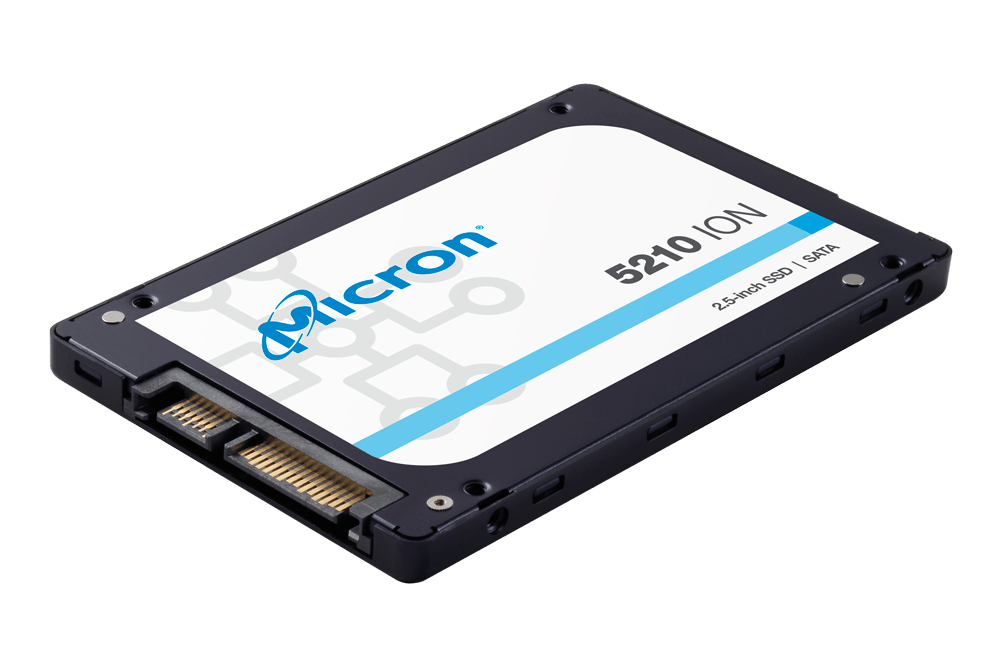Highlights
- Micron is first in the industry to produce QLC NAND technology for the data center.
- Micron’s QLC-based 5210 SATA SSD is leading the data center transition from HDDs to QLC SSDs, with new capacity and innovative workload intelligence to meet the needs of general-purpose servers and storage.
- Robust customer demand and OEM qualifications are driving Micron’s QLC SSD market adoption.
Singapore, April 8, 2020 — Micron Technology, Inc. (Nasdaq: MU), today announced new Micron® 5210 ION enterprise SATA SSD capacity and features, solidifying Micron’s leadership in QLC technology volume production. The world’s first QLC solid-state drive (SSD), the Micron 5210 is based on the company’s advanced QLC NAND technology and quickly replacing legacy hard disk drives (HDDs).
From SQL and NoSQL databases to big data and analytics, object stores and vSAN capacity tiers, customers are now reaping the benefits of NAND flash on performance-sensitive workloads that used to live on HDDs. Rapidly supplanting 10K HDDs, the Micron 5210 delivers 175 times faster random reads, 30 times faster random writes, two times more sequential throughput, and three times more energy efficiency than the largest 10K RPM HDDs1 — all at a compelling price point.
“The robust adoption of the Micron 5210 SSD since launching two years ago is indicative of the rise of QLC technology in the data center,” said Roger Peene, Vice President of Marketing for Storage Business Unit at Micron. “We are proud of the role we have played in driving adoption of the emerging QLC data center category, providing customers with benefits ranging from more speed and lower latencies to significant power savings and competitive economics.”
Original equipment manufacturer (OEM) adoption momentum is accelerating the industry’s transition from HDDs to QLC SSDs in general-purpose server workloads, improving their performance, reliability and power consumption.
“The new and innovative QLC wear-optimization technology engineered into Micron’s SSDs can enable customers to safely leverage SSDs for many of their workloads, addressing an important customer need as performance and capacity demands grow,” said John Donovan, Executive Director of Data Center Infrastructure at Lenovo Data Center Group. “Micron’s 5210 QLC SSDs are available today on Lenovo’s ThinkSystem solution portfolio.”
As workloads evolve to meet growing demands for real-time data insights and analytics, data centers increasingly need the steady-state speed, capacity, efficiency and reliability that enterprise flash storage can provide but HDDs cannot. High-density Micron QLC NAND flash media achieves densities of one terabit on a single chip, providing the ease and platform continuity of SATA, but with the value and speed of QLC NAND. The Micron 5210 ION SSD is optimized to meet these demands, delivering more compelling economics for enterprise storage compared with HDDs.
New 5210 Product Developments
- QLC firmware innovations — An industry first, Micron’s latest QLC custom firmware helps remove QLC endurance concerns and workload limitations, enabling QLC SSDs to reliably replace HDDs in general-purpose servers and storage.
- 960GB SKU — Micron’s new 960GB SKU (now generally available) satisfies strong customer demand to replace 900GB to 1.2TB 10K HDDs with cost-competitive SATA QLC SSDs.
- OEM qualifications — The Micron 5210 is now qualified by most major server OEMs, providing end customers numerous supply chain options and confidence that the 5210 has been stringently tested.
- VMware vSAN-certified — The Micron 5210 is newly certified on VMware vSAN and one of the most cost-effective ways to move to all-flash vSAN.
Availability
The Micron 5210 ION SSD is in mass production and available through nearly all major server OEMs, leading global distributors, resellers and system builders, with unit prices comparable to those of 10K enterprise HDDs. Contact your preferred OEM for more information.
Additional information on the Micron 5210 ION, including product specifications, is available at http://www.micron.com/5210
Resources
Library of workload white papers and research — Over 20 Micron white papers are now available on micron.com for numerous workloads historically deployed on HDDs. Highlights include the following:
o Getting business intelligence in SQL databases in less than an one hour vs. eight hours on HDDs
o Getting seven times more operations per second on NoSQL databases compared to HDDs
o Saving two hours performing Sort in Hadoop and running TeraGen 40% faster than HDDs
o Achieving eight times faster machine learning with the Micron 5210, as measured by Colfax Research
o Enabling massive data analytics with Apache Hadoop and Spark, when using 5210 HDFS storage with NVMe YARN cache
Twitter: https://www.twitter.com/MicronStorage
LinkedIn: www.linkedin.com/company/micron-storage
YouTube™: http://www.youtube.com/user/MicronTechnology
About Micron Technology, Inc.
We are an industry leader in innovative memory and storage solutions. Through our global brands — Micron® and Crucial® — our broad portfolio of high-performance memory and storage technologies, including DRAM, NAND, NOR flash and 3D XPoint™ memory, is transforming how the world uses information to enrich life. Backed by more than 40 years of technology leadership, our memory and storage solutions enable disruptive trends, including artificial intelligence, machine learning and autonomous vehicles, in key market segments like data center, networking, automotive, industrial, mobile, graphics and client. Our common stock is traded on the Nasdaq under the MU symbol.
© 2020 Micron Technology, Inc. All rights reserved. Information, products, and/or specifications are subject to change without notice. Micron, the Micron logo, and all other Micron trademarks are the property of Micron Technology, Inc. All other trademarks are the property of their respective owners.
1 Based on public data sheet values for the 1.92TB Micron 5210 SSD (70,000 IOPS) and SNIA PTSe IOPS industry-standard test results or 2.4TB 10K hybrid HDDs (rounded up to 400 IOPS). Actual performance may vary. Energy-efficiency comparison based on data sheet values for active average reads.






